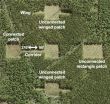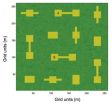(Press-News.org) A forest in South Carolina, a supercomputer in Ohio and some glow-in-the-dark yarn have helped a team of field ecologists conclude that woodland corridors connecting patches of endangered plants not only increase dispersal of seeds from one patch to another, but also create wind conditions that can spread the seeds for much longer distances.
The idea for the study emerged from modern animal conservation practices, where landscape connectivity – the degree to which landscapes facilitate movement – is being used to counteract the impacts of habitat loss and fragmentation on animal movement.
Gil Bohrer, Ph.D., an assistant professor in the Civil, Environmental & Geodetic Engineering department at The Ohio State University, and colleagues led by Ellen Damschen, Ph.D., an assistant professor of Zoology at the University of Wisconsin, wondered if similar interventions might aid plants that rely upon wind currents. The study, "How fragmentation and corridors affect wind dynamics and seed dispersal in open habitats," was published in the March 4 issue of Proceedings of the National Academy of Sciences of the United States of America and referenced in the February 27 issue of Nature.
The field experiment involved connecting open patches of land by cutting gaps and corridors out of a longleaf pine plantation around the Savannah-River National Laboratory near Jackson, S.C. A network of sensors was erected to provide observations on wind speed, turbulence, temperature and humidity at roughly 20 points throughout the experimental landscape. Seed traps sampled seed arrival at many points in and around the gaps and hundreds of artificial seeds made of black-light fluorescent yarn were released and recovered in several controlled experiments.
These very large experimental efforts provided a novel dataset of observations of seed movement and wind in patch-corridors landscapes. However, the researchers understood that reality is always much more detailed than can be observed. Therefore, to comprehend the fine details of the relationships between the forest gap structures and the wind, the scientists leveraged the physical model to generate a virtual and complete environment, where every detail of the wind and seeds movement and the forest structure are known.
Bohrer ran the dataset through a high-resolution atmospheric model that he had developed on OSC's IBM Opteron 1350 Glenn Cluster. The Glenn Cluster provides users with a total peak performance of 54 teraflops (tech-speak for making 54 trillion calculations per second), and the center's Mass Storage System provides more than 2 petabytes of storage.
"The massive simulations used the Ohio Supercomputer Center to provide a detailed understanding of how corridors change the movement of the wind, and seeds that disperse with it, through a forest," Bohrer said.
The model resolves the wind flow and includes the effects of canopy leaves and tree stems on the wind. The simulations include a virtual domain of roughly 6.5 million pixels, each representing a volume of air (or air mixed with forest leaves) of about 10 cubic meters. It also represented millions of dispersing virtual seeds. The model calculated the movement of the air and virtual seeds 20 times per second, over four hours.
"We found that corridors could affect the wind direction and align the wind flow with the corridor, that they accelerate the wind and provide preferable conditions for ejection above the canopy, where long distance dispersal could occur," said Bohrer.
INFORMATION:Funding for the project was provided by the National Science Foundation, the Center for Programs and the International Center for Advanced Renewable Energy and Sustainability at Washington University, the USDA Forest Service-Savannah River under interagency agreement with the Department of Energy, and the USDA National Institute for Food and Agriculture Air Quality.
Study finds forest corridors help plants disperse their seeds
Field study, computer simulations show how gaps affect wind dynamics
2014-03-19
ELSE PRESS RELEASES FROM THIS DATE:
Inflammation mobilizes tumor cells
2014-03-19
Researchers of Ludwig-Maximilians-Universitaet (LMU) in Munich have discovered a novel feedback mechanism that provides a mechanistic link between chronic inflammation and carcinogenesis.
Malignant tumors pose a major threat to survival largely because they shed mobile cells that can form secondary tumors in other tissues. This process requires a fundamental change in the character of cells within the primary tumor, insofar as members of a localized cell mass must be converted into actively migrating cells that invade into the surrounding tissue and blood vessels, and ...
IU, Regenstrief study: New noninvasive colorectal cancer screening tool highly accurate
2014-03-19
INDIANAPOLIS -- An Indiana University and Regenstrief Institute study of nearly 10,000 average-risk, asymptomatic men and women from 90 sites across the United States reports that a multi-target stool DNA test -- a new noninvasive colorectal cancer screening tool that has not yet been approved for sale by the Food and Drug Administration -- detects 92.3 percent of colon cancers, compared to only 73.8 percent of cancers detected by a fecal immunochemical test, the most commonly used noninvasive test today.
Study results were published online March 19 and in the April ...
Earliest evidence of limb bone marrow in the fin of a 370 million year old fish
2014-03-19
This week in the journal Proceedings of the Royal Society B, a team of French and Swedish researchers present the earliest fossil evidence for the presence of bone marrow in the fin of a 370 million-year-old fish.
Long bones, which are found in the limb of tetrapods, are not only important for locomotion and supporting the weight of the body, but also host the bone marrow. The latter plays a major role in haematopoiesis, i.e. the formation of blood cells. In a healthy adult human, about a hundred billion to one trillion new blood cells are produced every day to maintain ...
Internists must play a larger role in managing menopausal symptoms
2014-03-19
New Rochelle, NY, March 19, 2014—The number of menopausal women is projected to reach 50 million by 2020. With changing views on appropriate therapies to control symptoms and new treatments available and on the horizon, most internists lack the core competencies and experience to meet the needs of women entering menopause, according to a provocative Commentary published in Journal of Women's Health, a peer-reviewed publication from Mary Ann Liebert, Inc., publishers. The article is available free on the Journal of Women's Health website at http://www.liebertpub.com/jwh.
The ...
Genetic test could improve colon cancer screening
2014-03-19
A non-invasive test that includes detection of the genetic abnormalities related to cancer could significantly improve the effectiveness of colon cancer screening, according to research published by a team of scientists including David Ransohoff, MD, professor of medicine at the UNC School of Medicine and UNC Lineberger Comprehensive Cancer Center member. The large-scale, cross-sectional study was published online today in The New England Journal of Medicine.
The study compared two different types of tests used for screening colorectal cancer: a non-invasive, multitarget ...
Strategies for teaching common core to teens with autism show promise
2014-03-19
Scientists at UNC's Frank Porter Graham Child Development Institute (FPG) report that high school students with autism can learn under Common Core State Standards (CCSS), boosting their prospects for college and employment. Newly published recommendations from FPG's team also provide strategies for educating adolescents with autism under a CCSS curriculum.
"The number of students with autism who enter high school settings continues to grow," said Veronica P. Fleury, lead author and postdoctoral research associate with FPG's Center on Secondary Education for Students with ...
New technique makes LEDs brighter, more resilient
2014-03-19
Researchers from North Carolina State University have developed a new processing technique that makes light emitting diodes (LEDs) brighter and more resilient by coating the semiconductor material gallium nitride (GaN) with a layer of phosphorus-derived acid.
"By coating polar GaN with a self-assembling layer of phosphonic groups, we were able to increase luminescence without increasing energy input," says Stewart Wilkins, a Ph.D. student at NC State and lead author of a paper describing the work. "The phosphonic groups also improve stability, making the GaN less likely ...
Chemo-free treatment a possibility for leukemia/lymphoma
2014-03-19
Patients with terminal forms of leukaemia and lymphoma who have run out of treatment options could soon benefit from a new drug, which not only puts an end to chemotherapy and has virtually no side effects but also improves a patient's life expectancy and quality of life.
It has been described as a breakthrough in cancer treatment by a leading professor in haematology, who presented the findings of the Phase 1 trial at an international conference in New Orleans in December 2013.
Professor Simon Rule, Consultant Haematologist at Plymouth Hospitals NHS Trust and researcher ...
Neuroscience 'used and abused'
2014-03-19
Influential policy-informing 'evidence' that children's brains are irreversibly 'sculpted' by parental care is based on questionable evidence.
The researchers warn that the success that advocates of 'brain-based' parenting have had in influencing government policy could undermine parent-child relationships.
The study identified that although there is a lack of scientific foundation to many of the claims of 'brain-based' parenting, the idea that years 0-3 are neurologically critical is now repeated in policy documents and has been integrated into professional training ...
NRL researchers detect water around a hot Jupiter
2014-03-19
Scientists at the Naval Research Laboratory (NRL) are part of a research team that has detected water vapor in the atmosphere of a planet outside our solar system. The team, including scientists from California Institute of Technology, Harvard-Smithsonian Center for Astrophysics, Pennsylvania State University, and University of Arizona, applied a sophisticated Doppler technique to the infrared to directly detect the planet and demonstrate the presence of water in its atmosphere. The discovery is described in the March 10, 2014 issue of The Astrophysical Journal Letters.
The ...
LAST 30 PRESS RELEASES:
New fully digital design paves the way for scalable probabilistic computing
Membrane electrode assembly design for high-efficiency anion exchange membrane water electrolysis
U.S. debt ceiling disputes show measurable impact on global crude oil markets
Climate extremes triggered rare coral disease and mass mortality on the Great Barrier Reef
Direct observation reveals “two-in-one” roles of plasma turbulence
Humans rank between meerkats and beavers in monogamy ‘league table’
US fossil reveals early mass-burial event and ancient microbial attack
Sedative choice could improve outcomes for breathing tube patients
New superconducting thin film for quantum computer chips
Simulations reveal protein "dynamin" constricts cell membranes by loosening its grip
Nearly 1 in 5 UK emergency department patients cared for in corridors/waiting rooms
Heavy energy drink intake may pose serious stroke risk, doctors warn
Violence against women and children among top health threats: New global study reveals disease burden far larger than previously estimated
Predicting who is at risk of developing type 1 diabetes, as new drugs now available
New gene-mapping method unlocks hidden drivers of cancer
Ocean current and seabed shape influence warm water circulation under ice shelves
Call to increase funding for ‘invisible’ Deaf victim-survivors of domestic abuse
University of Maryland School of Medicine names distinguished scientist and academic leader Gerald M. Wilson, PhD, as Chair of the Department of Biochemistry and Molecular Biology
Receptors in mammary glands make livestock and humans inviting hosts for avian flu
Icy hot plasmas
Treating adults with autism: Maryland Clinical Center offers national blueprint for care after pediatric transition
University of Phoenix College of Doctoral Studies releases white paper on reclaiming control to build workforce resilience
NCCN Summit seeks to improve care for veterans and first responders with cancer from line-of-duty exposure
ERC Consolidator Grant for soft robotics researcher
Dual-action arts and wellbeing program transforms dementia care
The global plastic waste trade contributes to coastal litter in importing countries, study shows
UT Dallas partners with Tech Mahindra on AI innovation
Blinking less could signal the brain is working harder to listen, Concordia study shows
Male bonobos track females’ reproductive cycle to maximize mating success
New report outlines science priorities for human Mars exploration
[Press-News.org] Study finds forest corridors help plants disperse their seedsField study, computer simulations show how gaps affect wind dynamics








